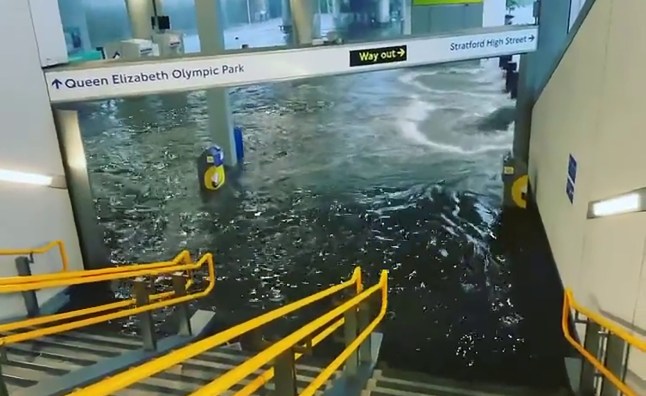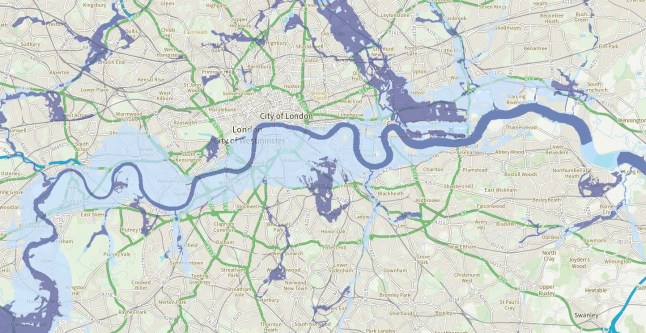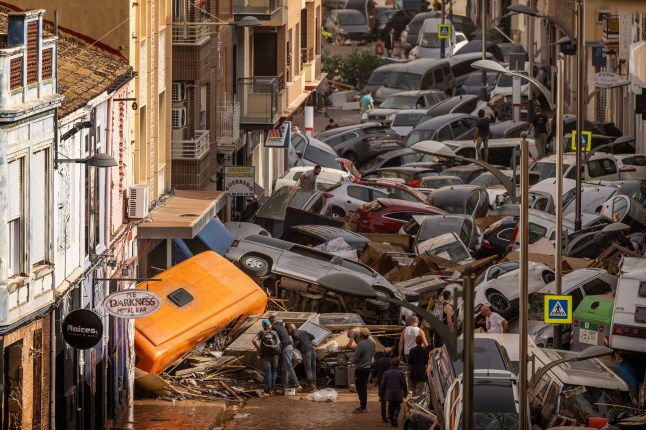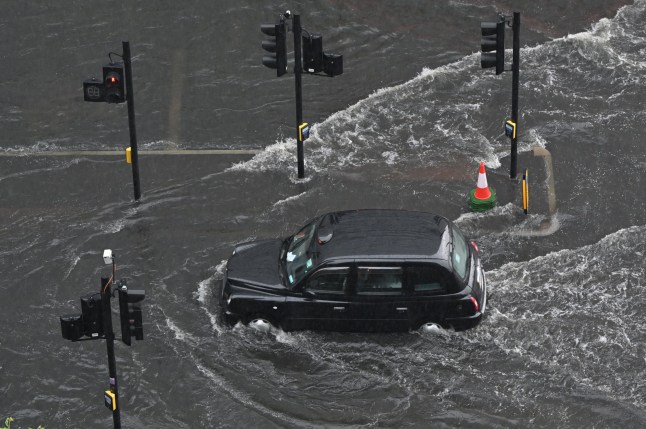
London is at risk of a disastrous flood, and we may not respond to the danger until it’s too late, water experts warned.
Last week, floods in Texas claimed the lives of dozens, including young girls staying at a summer camp along the banks of the Guadeloupe River.
Before this, flash flooding devastated the Spanish city of Valencia last October, leaving cars piled up in the streets, supermarkets underwater, and roads filled with mud and debris, killing over 200 people.
Could something this deadly happen here, too?
Hydrologists, who study water systems including flood risk, told Metro that essentially, it’s possible.
If there was a huge amount of rainfall in one day, the capital – like most cities – would not be able to cope with the deluge, and there could be deaths from people flooded as they slept, or while trying to escape in their cars.
Dr Jess Neumann, associate professor of hydrology at the University of Reading, said: ‘Just because we haven’t seen catastrophic floods in London yet doesn’t mean that it’s not going to happen, or that it couldn’t happen.
How at risk is your home from flooding?

‘We have a lot of impermeable surfaces and the area is prone to convective thunderstorms.’
While there are features that made the flooded regions of Texas and Valencia more vulnerable (steep hills to channel water, and a warm ocean nearby leading to more water in the atmosphere), London has vulnerabilities of its own, like a creaking Victorian sewer system, and huge areas concreted over, where water cannot be absorbed by the ground.
The Thames Barrier would do nothing to help if there was a huge dump of rainfall from a thunderstorm upstream.

Professor Jacob Tompkins OBE, a civil engineer and hydrologist, told Metro that while the barrier protects the capital from deadly storm surges, such as the one which killed hundreds of people on the east coast in 1953, it could even worsen flooding upstream.
‘If you close the Thames Barrier because of a sea surge, and at the same time you’ve got heavy rainfall, there’s nowhere for the rainfall to go,’ he said. ‘The river can’t flow out. So it stops the storm surge, but it could also flood London.’
In his view, while there are a lot of people thinking about and trying to manage flood risk, there is still a lack of urgency and joined-up thinking.
To view this video please enable JavaScript, and consider upgrading to a web
browser that
supports HTML5
video
‘Valencia had a full plan to prevent large catastrophic flooding, but it wasn’t implemented yet,’ he said. ‘It was on the backburner.
‘And you see these plans in cities all around the world: “We have a plan that will be implemented by 2050, or 2070”.
‘But it’s happening now. We cannot delay these plans – people are going to die.’
In July 2021, London was hit by flash flooding which affected more 2,000 properties, including underground stations, hospitals, and the shop of a dressmaker beloved by Princess Diana, at a cost of some £281 million in insurance claims.
Thames Water said they had ‘learned lessons’ from the incident, and London Mayor Sadiq Khan commissioned the city’s first ever Surface Water Strategy, which was published in May.
It warns that there are almost 320,000 properties at high risk of flooding in London, including ‘at least 56,000 basements, many of which are inhabited’.
This leads us to another of London’s risk factors for flooding. It may not be as obvious as paved over front gardens, but think about all the construction work going on behind hoardings on terraced streets.
With no room to extend to the side, thousands of homeowners have resorted to digging out basements for extra space for their home gym, bedroom, or even an entire new flat.
The waterproofed underground floors displace groundwater, and reduce the natural capacity to absorb and store water during a flood – but that’s not their only problem.
Dr Neumann said: ‘Basements are a huge risk if there’s flash flooding. They are usually downstairs, and so are the first place where water is going to enter.
‘The Texas floods struck around 4am. I hate to think what the potential could be for flash flooding in London at 3am if people were asleep in basement rooms – it doesn’t bear thinking about.’
Meterologists have long warned that extreme weather is becoming more likely, with one key reason being that warmer air holds more moisture, meaning the potential for more rain to fall.
According to the Met Office, the UK has already become wetter over the last few decades, with last year seeing the eighth wettest winter and sixth wettest spring on record. Storm Henk and Storm Bert brought widespread flooding, and in September, Oxford saw its rainiest calendar month for 250 years.
Four types of flooding that threaten London
- Pluvial (heavy rain causing both surface water flooding, and swelling rivers)
- Fluvial (rivers and streams bursting their banks)
- Sea surges from high tides, which the Thames Barrier was designed to prevent
- Rising groundwater, which overflows drains and sewers, and causes surface water
Civil engineers use the concept of stationarity, which assumes that historical trends of the past will be reflected in the future, including frequency of extreme rainfall.
But ‘there’s no such thing as a 100-year flood anymore,’ Prof Tompkins said, adding it’s not only London at risk from extreme flooding, but ‘every city in the UK’.
The Thames Barrier opened in 1984 in Woolwich, and its series of massive steel gates block tidal surges from the North Sea from washing out the Houses of Parliament and Borough Market (and the rest of central London).
But it is now over forty years old, and reaching the end of its lifetime as originally conceived.
Dr Neumann said: ‘With rising sea levels and more extreme weather events, we have to question how long the Thames Barrier is going to be able to keep London safe.’
The barrier has had to be raised more and more in recent years, but it is the risk from rainfall which really keeps hydrologists awake: in the July 2021 floods, a month’s worth of rain fell in just two hours.

Dr Neumann said the sewerage system ‘was not designed to deal with huge amounts of rainfall, so we quite often see drains just bubbling up’, even without such extreme levels.
The Surface Water Strategy recommends improving defences including small scale interventions like roof gardens, water butts, and more places where water can pool, which take the peak off the flood, and prevent disaster.
It also sets out plans to improve the sewerage system and create ‘catchments’, where authorities will work together better to tackle flooding, which does not respect local authority boundaries.
Dr Neumann said it is difficult to give early warning in flash floods driven by rainfall, because they can ‘happen in a matter of minutes’, and even when forecasters can tell that a thunderstorm will bring heavy rain, it’s hard to predict exactly where that will be.
Protect your home from flooding
Households at risk can invest in property defences beforehand, such as valves in toilets to stop waste water flowing back inside, and self-sealing air bricks.
Dr Neumann said: ‘For people who are at risk, I would also recommend investing in property flood barriers/defences across doors and windows, raising electrical sockets and considering use of materials that are more flood resilient in low-lying areas e.g. tiles in basements. This can make the clean-up operations easier.
‘Being prepared in the long term makes the difference in the event of a flood. People should check their long-term flood risk on the Government website and sign up to the Environment Agency free flood alerts and warnings if they are in an at risk area.

‘Having a flood kit prepared (with torches, bottled water, battery pack and phone charger, blankets etc), knowing how to turn off your gas and electricity and identifying a safe place to evacuate can be critical.
‘Hopefully we would never need to use these steps, but if we did, knowing what to do helps us be proactive in managing our risk and safety.’
Adding a water butt and rain garden, as well as ‘depaving’ by removing concrete and asphalt, can also help reduce the general flood risk.
Prof Tompkins said that flooding isn’t top of the priority list because it feels distant to many people: ‘We haven’t had the massive flood or the huge drought in living memory yet.
‘We’re very close all of the time, but no one realises,’ he said.
‘Rivers flood, that’s what they do and we haven’t given them the space to do that.
‘The water crisis is here but it’s just slow moving, and people don’t notice it until it puts its head above the parapet.’
Get in touch with our news team by emailing us at webnews@metro.co.uk.
For more stories like this, check our news page.









